Since 2002, I have circulated an annual message to commemorate Martin Luther King Jr. Day. This year, I am combining the message with a baseball story and sending it out to my Hot Stove subscribers plus friends who have received prior MLK posts. The holiday is two weeks away, but I need to send this out early because Rita and I leave Friday for a 10-day cruise out of LA. Rita will be traveling a little lighter – her appendix was removed last week. We will sail down the Baja and into the Sea of Cortez with the hope of seeing some whales and enjoying pleasant weather. [Note to those not on the Hot Stove list: If you are a baseball fan, especially of the nerd variety, and want some nostalgia and trivia on an irregular basis, you are welcome to sign up]
The theme for this year’s MLK message came to mind during a walk in New York this past September. In our quest for everything Hamilton, Rita and I visited the family home of Alexander and Eliza Hamilton on 145th Street and then walked south to Columbia University to see the marker at 118th Street for the Battle of Harlem Heights, one of Hamilton’s early war battles. In between, the walk took us through the Gothic-style campus of City College, Grant’s Tomb and Riverside Church. The church has hosted many dignitaries, but the one I knew about was Martin Luther King Jr. who delivered his historic speech in opposition to the Vietnam War at Riverside on April 4, 1967 (exactly one year before his death). What I had not remembered was that Riverside is also where Jackie Robinson’s funeral service was held in 1972. I decided to look into other connections between King and Robinson, and this also led me to Roberto Clemente.
The title of this post is derived from the title of the song “Abraham, Martin and John” written soon after the assassinations of Martin Luther King and Bobby Kennedy in 1968. The song is about the three men in the title plus Bobby, lamenting that “it seems the good die young.” The song was first recorded by Dion (click here).
MARTIN LUTHER KING JR. DAY – 2017 – MARTIN, JACKIE AND ROBERTO
Jackie Robinson signed with the Dodgers, played the 1946 season for its farm team in Montreal and then played his first major league game on April 15, 1947.
Roberto Clemente signed with the Dodgers, played the 1954 season for Montreal and then moved from the Dodgers to Pittsburgh where he played his first major league game on April 17, 1955.
Their cards from 1955:
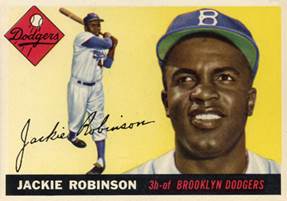
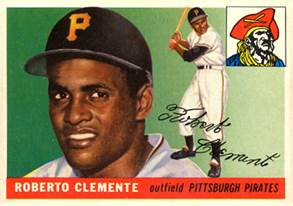
When Jackie played his first game in 1947, Martin Luther King was 18 and attending Morehouse College. When Roberto played his first game in 1955, King was finishing up his doctorate in theology. So Robinson and Clemente were both working on desegregation before King entered the national stage. Jackie had started in 1944 when he was court martialed for insubordination after refusing to move to the back of an army bus. He was acquitted and honorably discharged. On December 1, 1955, Rosa Parks refused to move to the back of her bus. Atlanta preacher Martin Luther King took up her cause and organized the Montgomery Bus Boycott for his seminal entry into what became a storied career in the Civil Rights Movement. Along the way, King would encounter both Robinson and Clemente.
Jackie and Roberto: Branch Rickey is given credit for building two great teams, the “Gas House Gang” in St. Louis and the “Boys of Summer” in Brooklyn. But he is likely best known for signing Jackie Robinson to integrate the major leagues. Rickey carefully guided Jackie through the early difficult years before leaving in 1950 to become the general manager at Pittsburgh. The Dodgers replaced Rickey with Buzzie Bavasi, and one of Bavasi’s key signings was Roberto Clemente in 1954. Under the arcane rules of the day, if a player was paid more than $6,000 for his initial season, he had to either (i) be on the major league roster or (ii) play in the minor leagues and be exposed to a supplemental draft after the season. In a bidding duel with the Giants, Bavasi paid Clemente more than $6,000 and took the risk of losing him by assigning him to Montreal for his first season. Some believe that Clemente was not played much in Montreal in the hope that no one would notice him. No such luck. The team with the first pick in the supplemental draft was Branch Rickey’s last place Pirates and Roberto was on his way to 18 seasons in Pittsburgh.
Why did the Dodgers fail to protect Clemente from the draft? They could have put him on the major league roster, but it was argued that 19-year-old Clemente needed more seasoning. A couple of theories point to racism. The Dodgers may have felt they already had enough black players although no team admitted to having quotas. The Dodgers had six black players on the 1954 roster, including future Hall of Famers Roy Campanella and Don Newcombe. Buzzie Bavasi has said that some of the Dodger owners were not concerned with a quota, but they also did not want to create a problem with their white players. He claims he checked with Jackie Robinson and that Jackie agreed with the Clemente decision because replacing a popular white player might set back the cause of integration in baseball. This may have been some myth-making by Bavasi as he did not tell this part of the story until 2005. Bavasi also said that signing Clemente “was a cheap deal for us” and kept the Giants from having Clemente and Willie Mays in the same outfield. And indeed it was cheap because white players were receiving bonus payments six times higher on average than black and Latino players (Clemente being both).
In Jackie’s final two seasons, the Dodgers reached the World Series, winning in 1955 and losing in 1956. As for Clemente, Branch Rickey (who it was said “could recognize a great player from the window of a moving train”) was not so sure about future stardom for his draft pick. Rickey would not be around to find out because he left the team in 1956. Clemente got better and new GM Joe Brown rounded out the team that Rickey started. In 1960, the 25-year-old Clemente evolved into an all-star and the Pirates won the World Series on Bill Mazeroski’s walk-off homer in Game 7.
Jackie and Martin: The Montgomery Bus Boycott led by King lasted from December of 1955 to December of 1956 – covering Jackie’s last season in baseball. A few months later, they were both presented with honorary degrees at Howard University. [Trivia: In the movie 42, Robinson is played by Chadwick Boseman, a graduate of Howard]
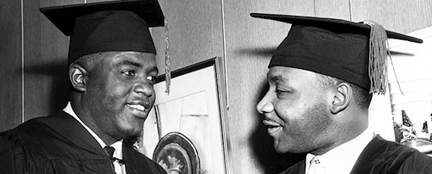
Jackie devoted a chapter of his autobiography to King. He had followed the saga of the boycott and how King reacted to the vicious opposition, including the bombing of King’s home. “I met Martin not long after the bombing. I had been extremely impressed by his calmness in the face of such terrible violence and threats to his family…I joined him whenever possible. I became a close friend and I began to understand the remarkable qualities that made him the leader he was. Godliness, strength, courage, and patience in the face of overwhelming odds were his chief characteristics.” The same could of course be said for Robinson.
Jackie became an activist after his playing days, saying “Life is not a spectator sport. If you’re going to spend your whole life in the grandstand just watching what goes on, in my opinion you’re wasting your life.” He raised funds for civil rights causes and joined King at many marches and events – here he is with his family in 1963 at the March on Washington:
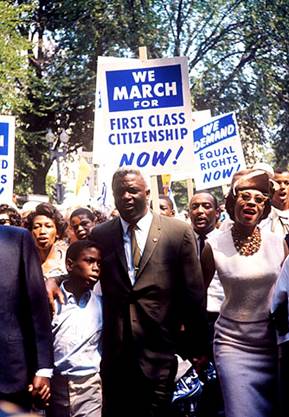
In his autobiography, Jackie says the he would not have been a good soldier in Martin’s army. Although he had been patient and not reacted to taunts when he first joined the Dodgers, he was not “conditioned to accept nonviolence in the face of violence-provoking attacks.” A related issue was King’s opposition to the Vietnam War. In 1967, Jackie wrote an open letter to King strongly attacking King’s position. King called Jackie to explain that his position on nonviolence made as much sense on Vietnam as it did in Montgomery, Selma and Birmingham. Jackie countered that the alliance of the civil rights movement and the peace movement was a “mismatched marriage.” Jackie came away from the call with even more respect for King even though Jackie was not fully convinced on the war issue. A few months later, King made his historic speech at Riverside Church in New York to describe in detail why he opposed the war.
At a meeting in Los Angeles in 1968, Jackie’s former teammate Don Newcombe met with King and was honored to hear these words: “Don, you’ll never know how easy you and Jackie and Doby and Campy made it for me to do my job by what you did on the baseball field.” As Newcombe recalled: “Imagine, here is Martin getting beaten with billy clubs, bitten by dogs and thrown in jail, and he says we made his job easier.” Just 28 days later, Martin Luther King was killed in Memphis. Jackie Robinson attended the funeral. Another baseball integration pioneer marched in the funeral procession – former Cleveland owner Bill Veeck who broke the color line in the American League with Larry Doby 11 weeks after Jackie’s first game.
Roberto and Martin: When Clemente came to the states, he was surprised by the extent of the prejudice against not only blacks, but Latinos. He was from Puerto Rico where integration was the norm. In addition to the indignities of Jim Crow which separated Clemente by race, his Latino background was an issue. Part of this was the language barrier, and some sportswriters even mocked his broken English. After he got the winning hit and was named MVP in the 1961 All-Star Game, the Pittsburgh Press headline quoted him, “I GET HEET.” This treatment angered him and he became assertive on questions of racial equality. He met with Martin Luther King several times and King visited Clemente at his farm in Puerto Rico. Clemente became a leader in the battle for black players to be able to travel, reside and eat with white players.
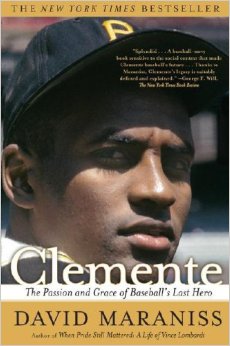
As recounted by David Maraniss in his definitive Clemente biography: “What Clemente admired most about King was not his philosophy of nonviolence, but his ability to give voice to the voiceless.” In Clemente’s words on King: “Now with this man, these people come down to the place where they were supposed to be, but people didn’t want them, and sit down there as if they were white and call attention to the whole world. Now that wasn’t only black people. The people who didn’t have anything, and that had nothing to say in those days because they didn’t have any power, they started saying things and they started picketing, and that’s the reason I say he changed the world…” Clemente gave both time and money to support his beliefs, and his philanthropy for those in need became part of his public image. His mantra was often quoted: “If you have a chance to help others and fail to do so you’re wasting your time on earth.” A nice parallel to the Robinson quote above.
Martin Luther King was assassinated on April 4, 1968, and his funeral was scheduled for April 9. This conflicted with the opening of the baseball season, and an indecisive Commissioner William Eckert left it to the individual clubs to determine if any games would be postponed. Some teams postponed their openers. One that did not was Houston, scheduled to play Pittsburgh in the Astrodome. Led by Clemente, the Pirates players refused to play, and he said “When Martin Luther King died, they come and ask the Negro players if we should play. I say ‘If you have to ask Negro players, then we do not have a great country.’” Other black players from around the league, including the Cardinals’ Bob Gibson, joined in the protest. The commissioner wisely reconsidered and postponed the opening of the season for all clubs until April 10.
1971 – Pittsburgh Pirates: Pittsburgh has a rich history of black baseball and fielded two premier teams in the Negro Leagues, the Pittsburgh Crawfords and the Homestead Grays. But it was still big news on September 1, 1971, when the Pirates started nine black players from a roster that was half black and Latino. Hate mail rained in, but that did not influence management or the players. This was a harmonious group than went on to win the World Series over the favored Orioles. After playing in his first World Series in 1960, Clemente had led the league in hitting four times, won a Gold Glove every year since 1961 and was MVP in 1966. In the 1971 Series, he hit .414 and was named MVP. Clemente had felt underappreciated, especially outside of Pittsburgh, and the Series provided a grand national stage for him to display his skills. It did not hurt that the TV audience was huge – Game 4 was the first night game in World Series history and is still in the top 10 viewed games. Roger Angell captured the moment in the New Yorker:
[The 1971 World Series was] “a shared experience, already permanently fixed in memory, of Roberto Clemente playing a kind of baseball that none of us had seen before – throwing and running and hitting at something close to the absolute perfection, playing to win but also playing the game as if it were a form of punishment for everyone else on the field. He is a frightening batter…a pitch…in his power zone is in imminent danger of departure…A proud and bitter man with his haughty, striking profile, Clemente is convinced that he is the finest ballplayer in the world. He believes that for various reasons – his frequent injuries, the fact that he is black, the fact that he is Puerto Rican and speaks English with an accent- he has been deliberately damaged by the press and kept from the kind of recognition and adulation that we have given to the Aarons and Mayses and Mantles of our time. Before that last game, he said to me, “I want everybody in the world to know that this is the way I play all the time. All season, every season. I gave everything I had to the game.”
1972 – Jackie: Jackie Robinson died at the age of 53 on October 24, 1972. His funeral was held at Riverside Church in New York where he was eulogized by Reverend Jesse Jackson. Roberta Flack sang a spiritual. Pallbearers included basketball star Bill Russell (front left below) and Jackie’s former teammates Ralph Branca, Don Newcombe, Pee Wee Reese, Joe Black and Jim Gilliam. Bayard Rustin, chief organizer of the 1963 March on Washington, is the white-haired gentleman at the very front of the photo. Players in attendance included Larry Doby, Hank Greenberg, Ernie Banks, Willie Mays, Hank Aaron, Monte Irvin and Roy Campanella (wheelchair in the photo).
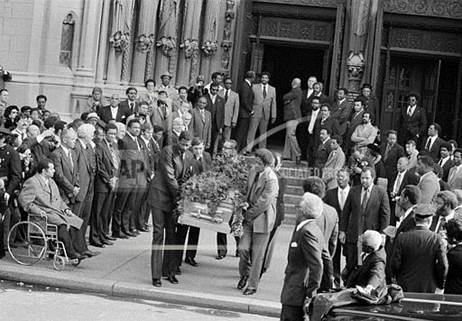
At the funeral, AP reporter Ken Becker spotted “a man in baggy chinos and a ratty gray sweatshirt, standing alone in the back, sobbing into a handkerchief.” It was Bill Veeck. Becker was also in the funeral procession that was viewed by tens of thousands of people, reporting that “As the hearse rolled slowly through Harlem, quiet, respectful crowds lined the sidewalks. Children in school uniforms stood at attention. Women sat on stoops, heads buried in their hands. Old men leaned against the lampposts and wept.”
1972 – Roberto: On the last day of the 1972 regular season, Clemente hit a double in the 4th inning for his 3000th hit – the 11th player to do so. [Trivia: Clemente was lifted for pinch hitter Bill Mazeroski in his next scheduled at bat and so his 3000th hit would be his last at bat in a regular season game. Maz and Roberto were the only Pirates who played in the both the 1960 and 1971 World Series.]
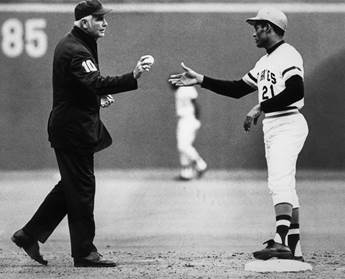
The Pirates won their division, but lost the NL pennant to the Reds who then lost the Series to the A’s. Clemente returned home to Puerto Rico, signed on as manager to the national team and took them to Nicaragua for the amateur world championships. A couple weeks after returning home, he was shocked to hear of the devastation caused by an earthquake in Nicaragua on December 23. To him, this was very personal as he had much enjoyed the sights and people of Nicaragua. He joined in raising money and supplies for the relief efforts. When he heard that supplies were being diverted for profit, he felt he needed to go to Nicaragua to assure proper distribution of the aid. He arranged for a plane and supplies and took off on New Year’s Eve of 1972. The overloaded plane crashed soon after takeoff, and Puerto Rico lost its patron saint of baseball – and one of its top humanitarians.
Legacy: In 1962, Jackie Robinson and Bob Feller became the first two players elected to the Hall of Fame in their first year of eligibility (other than the inaugural class of 1936). On April 15, 1997, the 50th anniversary of Jackie Robinson’s first game, Major League Baseball retired his #42 for all 30 teams. The 13 players then with the number were allowed to continue until retirement. Fittingly, the last person to wear #42 was a no-doubt Hall of Famer, Mariano Rivera who retired after the 2013 season. Since 2009, all players wear #42 in the games played on the April 15 anniversary. The Rookie of the Year Award, which Jackie won in 1947, was renamed in 1987 as the Jackie Robinson Award.
Eleven weeks after Roberto Clemente’s death, he was voted into the Hall of Fame by a special election, an honor shared only with Lou Gehrig who was inducted in 1939 while fatally ill. He was the first Latino in the HOF. In 1971, baseball established the “Commissioner’s Award” to be presented to the MLB player who “best exemplifies the game of baseball, sportsmanship, community involvement and the individual’s contribution to the team.” In 1973, the award was aptly renamed the “Roberto Clemente Award.” It is considered one of the most prestigious awards in baseball.
Martin, Jackie and Roberto. Abraham, Martin and John. “It seems the good die young” (as sung by Marvin Gaye, and yes, Marvin also died young). Click here.
As you honor the coming holiday for Martin Luther King, please also reflect on the legacy of Jackie Robinson and Roberto Clemente in the march for equality and justice. And also remember the way they played baseball.
Jackie: (click here, 3:28).
Roberto: (click here, 3:56).
One thought on “Hot Stove #31 – Martin Jackie and Roberto (Martin Luther King Jr. Day – 2017)”
Comments are closed.